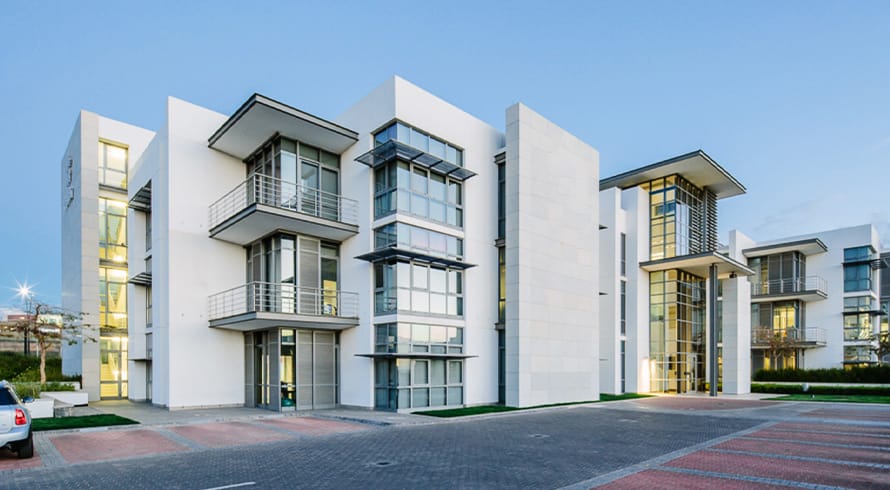Building towards a sustainable South Africa
At a glance
- South Africa is actively pursuing a low-carbon economy through various initiatives and programs.
- The construction and use of conventional buildings contribute significantly to carbon emissions.
- The Green Building Council of South Africa provides certification for green buildings, promoting environmental sustainability and occupant well-being. Additionally, SMEs in South Africa can access funding to make their buildings more environmentally friendly through a loan package.
The sources of carbon emissions are extensive. According to Du Plessis, 2015 the construction and use of conventional buildings require significant raw materials, as buildings consume 70% of global timber products; 50% of all resources used globally; 45% of all energy generated through heating, lighting and ventilation; and 40% of water used globally through sanitation and other uses. As such, the construction and use of buildings accounts for significant scope 2 and scope 3 emissions:
- Scope 2 emissions are indirect GHG emissions associated with the purchase of electricity, steam, heat, or cooling; and
- Scope 3 emissions are the result of activities from assets not owned or controlled by an organisation, but that indirectly impact its value chain, such as the generation of waste, commuting of employees, upstream and downstream transportation, and distribution of goods and services.
In recent years we have seen a movement towards the design, construction and retrofitting of certified green buildings, and an increased focus on the reduction of the environmental footprint of buildings during construction and operation. The development of green buildings benefits both the environment and the overall health and well-being of their occupants.
The Green Building Council of South Africa developed a set of rating tools to create a standardised measurement for green buildings. It assesses various categories such as energy, water, emissions, transport and land use and ecology. The rating system awards points to a building for each of these categories. A building is then allocated an overall score based on the appropriate weighting of the environmental initiatives that were incorporated in the building. Green Star Certification includes the following ratings:
- 4 Star Rating, which recognises best practice;
- 5 Star Rating, which recognises South African excellence; and
- 6 Star Rating, which recognises world leadership.
Green Star Certification also includes a 1- to 3-Star Rating for existing buildings, which may take longer to improve while occupied and in use. The benefits of being Green Star certified enable a project or building to gain market recognition as a leader in the green building industry, enjoy the benefit of cost savings during operational phase of the building, and tax deductions for the amount of kilowatts per hour saved.
Legislative landscape
The certification of green buildings is not currently prescribed by any laws in South Africa and is an international best practice standard. In terms of regulating building standards, the National Building Regulations and Building Standards Act 103 of 1977 sets out the construction and development requirements for buildings in South Africa. The South African Bureau of Standards, which sets out the standards for the building industry, introduced the South African National Standard 10400 in 2011, which sets out, amongst other things, the environmental sustainability and energy use standards for buildings.
The energy use and performance of specific buildings will also need be displayed before the end of this year as the Energy Performance Certificate Regulations published under the Energy Regulation Act 4 of 2006 provides that public sector buildings larger than 1,000m² and private sector buildings larger than 2,000m² must publicly display their energy performance certificates by December 2022 or face the risk a fine of R5 million, five years’ imprisonment, or both.
Design guidelines have also been introduced at municipal level to encourage more green buildings. The City of Johannesburg published its Design Guidelines for Energy Efficiency in Buildings in 2009, which encourage commercial and retail buildings to be retrofitted with energy-conserving devices in order to reduce operating costs.
Loans to SMEs
Small and medium enterprises (SMEs) of industrial and retail sites in South Africa have recently been given an opportunity to access funding to make their buildings more environmentally friendly. This comes off the back of the announcement by the International Finance Corporation of a R600 million loan package to Business Partners Ltd, a South African non-banking financing entity that specialises in providing financing to SMEs.
The loan is set to finance the construction of green commercial buildings or renovations of existing commercial buildings in South Africa, to achieve benefits such as being 20% more energy efficient. Various innovative methods can be used to making a building greener, such as moving away from coal-fired electricity; making use of more natural lighting; harvesting rainwater; using environmentally conscious building materials; planting water friendly gardens; and using solar geysers.
This loan presents SMEs with the opportunity to reduce their carbon footprint and contribute to South Africa’s just transition towards a low-carbon economy and its commitments under the Paris Agreement. In addition, the greening of buildings also provides other benefits, such as contributions to job opportunities within the construction sector; the alleviation of pressure on the already constrained national electricity grid; and a chance for companies to improve on their environmental, social and governance obligations and performance.
It is estimated that approximately 100 to 120 buildings will be assisted with this loan. While this may seem insignificant in the grand scheme of things, every small contribution to transitioning towards a sustainable future is necessary.
The information and material published on this website is provided for general purposes only and does not constitute legal advice. We make every effort to ensure that the content is updated regularly and to offer the most current and accurate information. Please consult one of our lawyers on any specific legal problem or matter. We accept no responsibility for any loss or damage, whether direct or consequential, which may arise from reliance on the information contained in these pages. Please refer to our full terms and conditions. Copyright © 2024 Cliffe Dekker Hofmeyr. All rights reserved. For permission to reproduce an article or publication, please contact us cliffedekkerhofmeyr@cdhlegal.com.
Subscribe
We support our clients’ strategic and operational needs by offering innovative, integrated and high quality thought leadership. To stay up to date on the latest legal developments that may potentially impact your business, subscribe to our alerts, seminar and webinar invitations.
Subscribe




